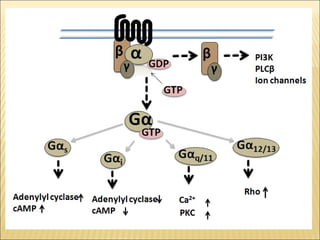G12,13
- 1. G alpha 12,13 Protein Made by: Adel Mohie Under supervision of: DR. Maysaa
- 3. GÎą12/13 are the unique Îą subunits of a class of heterotrimeric G proteins along with GÎąS, GÎąi/o, and GÎąq. Îą12 and Îą13 were initially cloned from a mouse brain cDNA library by PCR and show 67% amino acid identity with each other but only 35-40% with other GÎą subunits. These Îą subunits are expressed in most tissues and are activated by over 25 receptors The GÎą12/13 polypeptides have a Mol Wt of 43,000Â
- 4.  in several cell types Gι12 and Gι13 have shown different subcellular localization with Gι12 localized to the plasma membrane while Gι13 localizes to the cyosol and upon stimulation translocates to the plasma membrane. Gι12/13 not ribosylated by Pertussis or Cholera toxin. Pertussis toxin has proven to be an important tool in the dissection of G protein-mediated pathways. Certain a subunits can be ADP- ribosylated by this toxin, resulting in Uncoupling the G protein from receptors
- 5. Gι12/13 stimulates RhoA(Ras homolog gene family, member A ). RhoA activates ROCK (Rho-associated, coiled-coil containing protein kinase 1) which stimulates LIM kinase(actin- binding kinases that phosphorylate members of cofilin), which then stimulates cofilin (is a family of actin binding proteins which disassembles actin filaments) which effectively reorganizes the actin cytoskeleton of the cell. Gι12/13 Signaling pathway
- 7. Role of GÎą12/13 in Cancer It is known that in order to metastasize cancer cells need to acquire motility. During cell migration, a cell contracts at the trailing edges. Cytoskeleton reorganization is also required for the the formation of lamellipodia and fillopodia (cytoskeleton actin protein).
- 8. Rho A is a small GTPase regulated protein known to control the actin cytoskeleton structure which results in the formation of stress fibers. Rho A modulates the actin cytoskeleton reorganization by activating ROCK which ends up activating cofilin through LIM kinase activation. It has been shown that TXA2 by binding to its cognate G protein coupled receptor causes the activation of RhoA which goes on to bring about actin cytoskeleton reorganization and manifests in the form of cell motility.
- 10. Two commercially prepared potent shRNAs, shRNA- 909 and shRNA-911 were utilized to investigate their biological effects on prostate cancer cells. It is generally believed that G alpha 12/13 promotes the invasiveness as well as cell proliferation. . Inhibition of GÎą12/13
- 11. When analyze the effect of G alpha 12 silencing on the invasive properties of prostate cancer by conducting wound-healing assay and chamber migration assay. studies showed that silencing of G alpha 12 significantly inhibit the would-healing process as well as cell migrating ability of prostate cancer cells.
- 12. The ability of the cells to close the gap with subsequent establishment of new cell-cell contacts depicts the migratory capability of cancer cells in metastasis. G alpha 12 shRNAs significantly inhibited the migration capability of PC-3MM cells. These results are in full agreement with a recent finding that G alpha 12 promotes prostate cancer metastasis.












